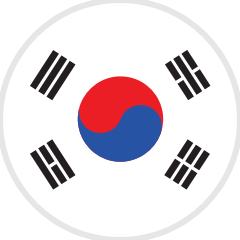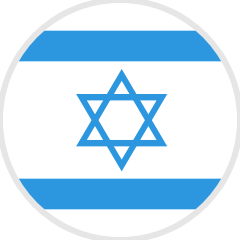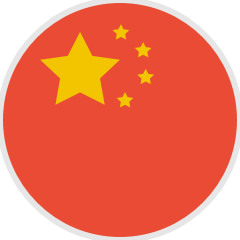You’ve tried your hand at language learning, but it’s never worked. That’s about to change: let’s show you how to become fluent in your target language with these 11 tips.
What is the fastest way to learn a language?
One of the most frequent questions we get in our inbox is How quickly can I become fluent in a language? Usually, the query comes from people who are either starting to learn a second language or have tried to without succeeding.
The answer depends on what you define as fluent, how much effort you’re willing to put in, and the method you use. And you have to use the right method.
After attempting – and failing – to learn a new language using different systems, apps, and tools, many are left discouraged and wondering what is the best and fastest way to learn a language. So, if you’ve tried to learn a foreign language without success, or you’re in a rush to do so, don’t give up – we’re here to help.
We’ve put together this ultimate guide that will show you how to learn a language fast following 11 of the most efficient language-learning tips out there, bar none. So, if you’re in a hurry and eager to learn a new language, let’s get to it.
Before we begin, it’s worth mentioning now that the Fluent Forever app and Live Coaching program together incorporate the most important tips outlined here, conveniently compiling the tools that will show you how to learn a new language fast. If you haven’t already, make sure to check both of them out.
- Start with your end goal
- Learn one language at a time
- Find ways to stay motivated
- Learn pronunciation early on
- Learn the words that matter
- Skip translations and use flashcards
- A novel approach to grammar
- Immerse yourself and have fun!
- Practice with native speakers
- Learn from your mistakes
- Try the perfect combo: Fluent Forever app + 1-on-1 Coaching
1. Start with your end goal
Firstly, it’s important that you define from the start why you’re learning a new language. From there, you can set up a concrete goal to reach. There’s no use in finding the fastest way to learn a language if you don’t know where you’re going. What’s your end goal with your target language? What’s the reason you’re learning it? People learn a new language for a variety of reasons, and you should start by finding out yours. It might be:
- Relating better to family members or friends who speak another language
- Improving job opportunities inside or outside their work
- Getting into a school or academic program in another country
- Traveling or moving to a different country
- Wanting to talk to a romantic interest or partner in their native language
In this way, knowing your end goal from the start will motivate you throughout the process and help you in setting up a structured action plan for success. In short, the fastest way to learn a language starts with slowing down and thinking about why you’re doing this.
Think S.M.A.R.T. about your goal
Secondly, it’s important that your goal is realistic and feasible, considering your resources, time, and needs. Set up a plan with deadlines, and create tasks for you to complete in order to reach your ultimate goal.
You can do this by setting up S.M.A.R.T. objectives. S.M.A.R.T. stands for Specific, Measurable, Achievable, Realistic, and Time-bound. Together, they embody how to learn a language fast and efficiently.
Specific: First, be specific. The more specific your objectives are, the quicker they’ll be to achieve. Avoid being ambiguous about them, and try to answer as many questions as possible from the get-go. You can start by asking yourself different questions:
- What do I need to reach my language learning goal?
- Do I need help from someone to get there?
- When will I start learning my target language?
- Where can I get help if needed?
- What tools and resources do I need to make progress?
Measurable: Second, you need proof to know if you’re on track to reach your goals. Find ways to measure your progress, like words and phrases known, conversation topics mastered, or scores from online tests. The fastest way to learn a language involves reaching small milestones that keep you motivated and pumped!
Achievable: Third, think about whether your objectives are achievable. Not reaching them can demotivate you and slow down your linguistic progress along the way. Therefore, think about your own resources, and find out if others have gotten there before under similar circumstances. Make sure that what you want can actually be done as quickly as you want it.
Realistic: Fourth, make sure your language learning objectives can exist together with your other responsibilities in life: school, work, family and friends, hobbies, and lifestyle. If can reach your objectives with everything else going on in your life, they’re realistic enough.
Timebound: Fifth, strap a deadline on your objectives and add some healthy pressure to your race towards fluency. Deadlines are essential to make objectives measurable, achievable, and realistic.

Image by Nile from Pixabay
Lastly, to help you out, here are some examples of S.M.A.R.T.-enhanced language learning goals:
- Learn perfect French in three years by talking with your language tutor three times a week
- Hold an advanced conversation in Spanish – politics, the environment, public health – in one year by studying for two hours a week for one year
- Learn farewells and greetings in Dutch in two weeks with 30 minutes of daily practice
While this might seem unrelated to learning a new language, trust us: a solid learning plan is the fastest way to learn a language in the long run.
How long should I study to learn a language?
“Is one hour a day enough to learn a language?” This is a frequent goal-related question we get. The truth is, the more time you spend studying your language, the faster you’ll learn it. However, everyone’s life is different, and what’s important is getting in as many hours as possible considering your situation. So, if you can do one hour a day, which for some people is considerable and impressive, go ahead and do that!
In other words, what matters is that you find a time that works for you, and then stick with it. We compiled some handy time management tips and tools for language learners that might help you with this.
2. Learn one language at a time
Can you learn two languages at the same time? While it’s not impossible, it’s not recommended if you’re looking for the fastest way to learn a language.
In short, there’s a correlation between effort applied to a given task and how fast you’ll see a positive end result. Consequently, splitting your attention into two might sabotage your efforts and slow down your progress. Certainly, you’re better off spending your resources – time, effort, and energy – on one single language to get the most out of your time and reap the benefits faster.
That being said, if you want to learn two languages at once, go for it. However, realize that results will take longer. Lastly, help yourself on this front by learning two languages in entirely different linguistic families – say, French and Japanese – to avoid confusion during the process.
3. Find ways to stay motivated
“How do I stay motivated to learn a language?” We’ve heard that question countless times. And with good reason: when it comes to the fastest way to learn a language, motivation is queen. Without it, the learning process decelerates and becomes tedious. Therefore, it’s crucial to find ways to keep you pumped about learning a new language, and there are several ways you can do this.
Write down the new perks you’ll get
Learning new languages comes with many perks we tend to forget about. With a new language living in your head, you open the door to a myriad of possibilities that were previously unavailable. So, write down all the great things you’ll access with your new language, and make sure to keep them close. Here are some examples of the many opportunities you’ll get:
- Travel more confidently to other countries where they speak your target language
- Make yourself more attractive in an increasingly globalized job market
- Meet new, interesting people from other cultures and nations
- Make studying abroad a more plausible and enjoyable experience
- Enjoy media like music, movies, and books in their original, unconstrained language
Hint: Follow Fluent Forever’s Pinterest board to discover other fun and interesting ways to learn a new language.
Find a learning buddy
We’re social creatures – that’s a fact. And, regardless of how much of a solo journey learning a language can be, finding a learning buddy to accompany you along the way can be a considerable plus for some people. Here’s why:
- Accountability: By letting someone know about your language goals, they can check up on you to see how you’re progressing. Similarly, they can remind you of your tasks and milestones coming up. And vice versa, of course.
- Moral support: A learning partner can cheer you on and pick you up when the going gets tough. Reciprocal love and support go a long way!
- Teamwork effect: Some people feel motivated when working in a team. Therefore, getting a language buddy can mimic that and boost your and their motivation. It’s a win-win!
There are many places to find a language learning buddy. Social media is teeming with groups of language enthusiasts willing to help each other learn a new language. Fluent Forever’s Language Learning Community is a great place to start if you’ve purchased any Fluent Forever product – whether it’s the app, book, tools and resources from our Language Shop, Live Coaching, or all of them. If you have the means, you could also consider getting a personal language coach as your buddy!
Test your skills
Periodically testing your language skills is a great way to keep you motivated. Think about it: if you know you’re taking a test in the future, you’ll keep your skills and focus sharp. At the same time, tests serve as important indicators of how you’re progressing.
You can find tests for different languages online. The ACTFL Oral Proficiency Interview (OPI), for example, includes various languages and is widely popular and recognized in different language learning communities. The ESL, HSK, and JLTP are three other tests, albeit language specific for Spanish, Chinese, and Japanese, respectively.
4. Learn pronunciation early on
Have you ever been introduced to a term in a new language, only to forget it seconds later? This happens because our brains are hardwired to identify the sounds of our native tongue. Therefore, the fastest way to learn a language involves rewiring our ears to hear and retain the words of our target language.
By training your brain and ears to recognize your target language’s new sounds, you’re preparing them to learn an entirely new language more easily. This, in turn, will make acquiring and remembering new vocabulary more efficient, accelerating your path to fluency. Plus, correcting pronunciation later on can be hard, so learning it early can save you precious time.
You achieve this by testing yourself using minimal pair words, which are words that sound almost identical but not quite (think “lock” and “rock,” “rue” and “roux,” for example). By practicing to identify which of the two words you’re hearing, your ears get better at picking up, learning, and remembering your new language’s pronunciation.
Hint: Interested in learning more about minimal pair tests? You can read the study that inspired Fluent Forever to use this method.
5. Learn the words that matter
An average English dictionary will show you, from A to Z, around 171,146 words. However, if you’re learning English, you don’t need to learn all of those words, but only the ones you’ll use the most.
You see, the fastest way to learn a language is to learn the most useful words first. Don’t waste your precious studying hours memorizing words you’ll never use or see. For instance, a specific list of 1,000 English words makes up 90% of most books, websites, and newspapers you’ll encounter. These groups of words are called frequency lists, and most languages have one.
Learning from a frequency list and focusing on, say, the 625 most common words, will speed up your path to fluency more than learning random vocabulary aimlessly. If you’re looking for pre-made frequency lists, you can check out Fluent Forever’s Most Awesome Word Lists.
You can also browse these sources for common words in Spanish, German, French, Japanese, Italian, Dutch, Russian, and Chinese. And don’t forget! You can learn all of these languages in the Fluent Forever app.
6. Skip translations and use flashcards
The mainstream method for learning words in a new language is through direct translations. Unfortunately, this is an ineffective and boring way to learn new vocabulary. Through this method, it’s easier to forget words, which, in the long run, slows down your progress. As a result, people who use apps like Duolingo, which rely on translations, may struggle to retain valuable vocabulary.
What you want to do is think in the language you are trying to learn, and create personal connections with the words you’re learning without relying on translations. You do this by using flashcards with images, pictures, and drawings, and taking advantage of spaced repetition systems (SRS). That’s essentially the tried-and-tested fastest way to learn a language and its vocabulary.
Using flashcards creates a personalized experience that can help you retain and recall vocabulary, grammar, and sentence structure for longer. By using SRSes, which gradually increment the time between flashcards reviewed, your ability to learn new words is enhanced.
Depending on whether you’re making physical, paper flashcards or using software like Anki, creating these handy tools can take different amounts of time. If you’re looking for a simple option that keeps the personalized experience and benefits of making your own flashcards, the Fluent Forever app simplifies the process of flashcard creation and uses an SRS algorithm, saving you valuable hours and accelerating your journey to fluency.
7. A novel approach to grammar
Regardless of the language, grammar is undoubtedly important – it gives sentences structure and a sense of who’s doing what. However, mastering the fundamentals of a language trumps obsessively delving into the nitty-gritty of grammar rules. The fastest way to learn a language does not involve memorizing conjugation tables, scribbling through repetitive exercises, and poring over strict rules from obscure textbooks. Rather, it’s all about learning the basics of word order, sentence structure, and verb tenses. And that’s how you learn a language fast.
That being said, we suggest that you do pick up grammar using the tools you’re already familiar with: flashcards. You can learn grammar using stories and sentences that you know or are interested in learning. This is a better use of your time, and, more importantly, it’s more effective and less boring than memorizing rules from textbooks. Here’s a handy guide on how to learn grammar with flashcards.
In conclusion, remember that when it comes to the fastest way to learn a language, speaking and being understood beats a perfect understanding of grammar every time.
8. Immerse yourself and have fun!
Michael Geisler, vice president of language schools at Middlebury College in Vermont, US, which runs one of the best full immersion language programs in the world, believes that the more you surround yourself with your target language, the faster you’ll progress. You do this by reading, listening, and speaking as much as you can in the language. That’s the perfect recipe for how to learn a new language fast and have fun while doing it.
If you can’t travel abroad or enroll in a full immersion program, here’s how you can mimic immersion at home or in your day-to-day routine:
- Change the language options on your electronic devices – like your phone, computer, and tablet – to your target language
- Create flashcards for everyday objects around the house to promote thinking in the language
- Consume simple media, like children’s books and comics, in the language you’re learning
- When you feel more confident, try watching series with and without subtitles, and reading short stories
- Follow the news of countries where they speak the target language
- Find and play board and video games in said language
9. Practice with native speakers
Speech in a foreign language is a skill that takes time to develop. Therefore, the sooner you get feedback on it, the better. Listening to how native speakers talk and getting corrected by them is the fastest way to learn a language effectively with real-life practice.
Ideally, you should spend some time abroad to surround yourself with native speakers who, most likely, don’t know your mother tongue. However, if this is outside of your possibilities, there are practical and fun workarounds.
First, you can find an exchange partner in an online language community on social media, or on websites like My Language Exchange. Second, you can join a community volunteer group made up of nationals who speak the language. Lastly, if your budget allows it, you can work with a tutor to get 1-on-1 lessons with a native speaker.
Out of the three, the latter will most likely yield the fastest progress. That being said, every option will provide positive results, as feedback from native speakers is an invaluable tool for language learners.
10. Learn from your mistakes
Mistakes are proof that you’re trying, and that therefore you’re learning the language in the process of making them. Additionally, they put you one step ahead in the right direction once you correct them. The more mistakes you make and learn from, the quicker you get them out of the way and keep on sailing towards your fluency goal.
Learning a new language is quite a journey, and like every journey worth making, you need to keep moving forward. You’ll surely make missteps and get frustrated, and that’s OK. Be kind to yourself, and remember that every error made and corrected is one step closer to becoming fluent.
11. Try the perfect combo: Fluent Forever app + 1-on-1 Coaching
The Fluent Forever method takes you through four stages of language learning that are rooted in neuroscience, providing you with the fastest way to learn a language and retain it for the longest time.
Starting by downloading the Fluent Forever app, you’ll get to learn the essential pronunciation, vocabulary, and grammar of one of the 11 languages available, doing so through the awesome power of minimal pairing, personalized flashcards, and spaced repetition systems (SRS). These super tools will prove to be the most efficient way to grasp your target language and its fundamentals.
Additionally, when you sign up for Fluent Forever’s Live Coaching, you’ll get flexible, personalized 1-on-1 lessons with a language coach who’s a native speaker that’s trained in the company’s methodology. Together with you, they will co-create customized sessions based on your goals and interests, helping you learn faster.
Let’s take a detailed look at each of the four language learning stages.
Stage 1: Rewire your ears
As we said in tip #4, it’s hard to learn new, foreign words if you can’t hear them properly. To help you with this, the Fluent Forever app has hundreds of minimal pairing tests available per language offered. Consequently, you’ll be able to identify and understand your language’s new sounds in a matter of weeks, so you’re ready to learn vocabulary faster and more efficiently.
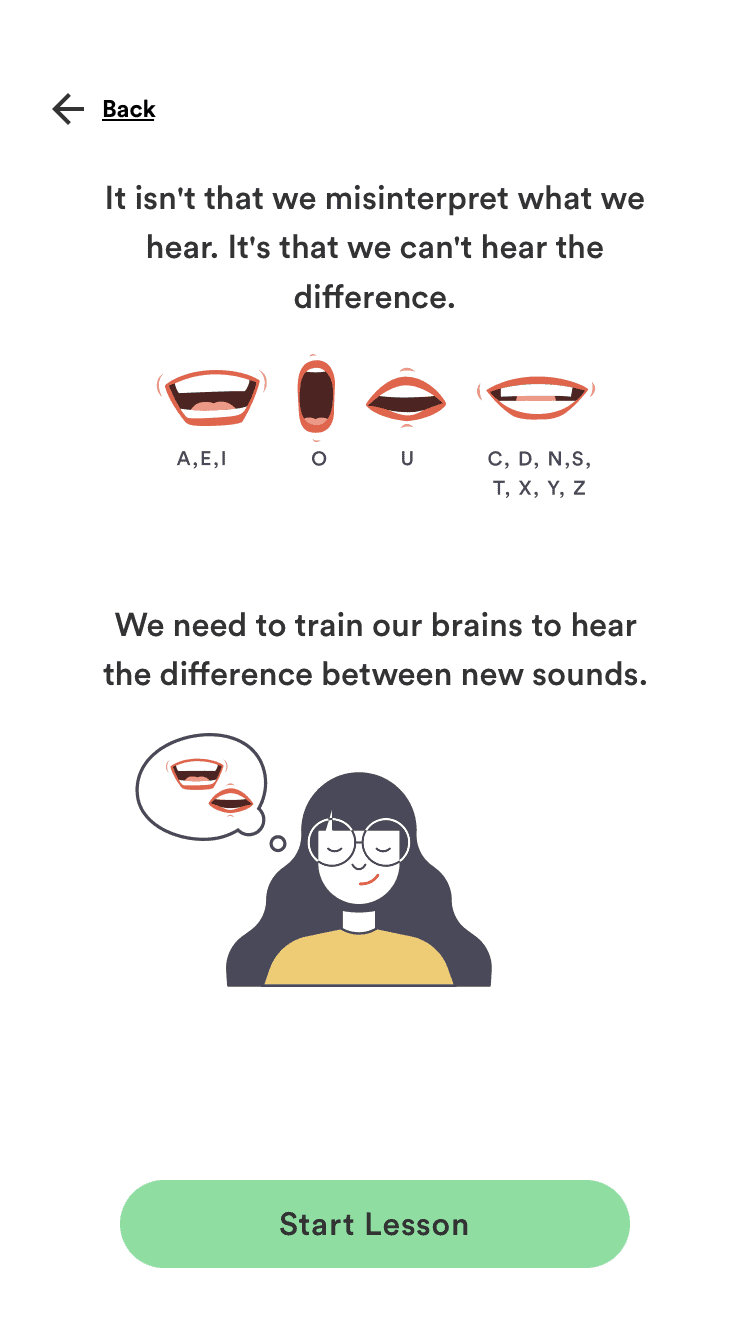
Stage 2: Base vocabulary with no translations
With your ears rewired, you can start learning essential vocabulary in your target language. And, more importantly, you’ll do this using the right tools: with flashcards, and saying no to translations.
The app automates the process of making personalized flashcards with images, drawings, or pictures. In this way, it will accelerate your language journey and allow you to focus on the most important bit: the learning part. Additionally, it’s integrated with an SRS algorithm, so it ensures that you review words exactly when you need to so that you learn and remember new vocabulary quickly and efficiently.
The words you’ll learn are based on a specific frequency list, and they’re fully customizable. What this means is that you can choose which words matter to you and skip the ones you don’t care about learning.
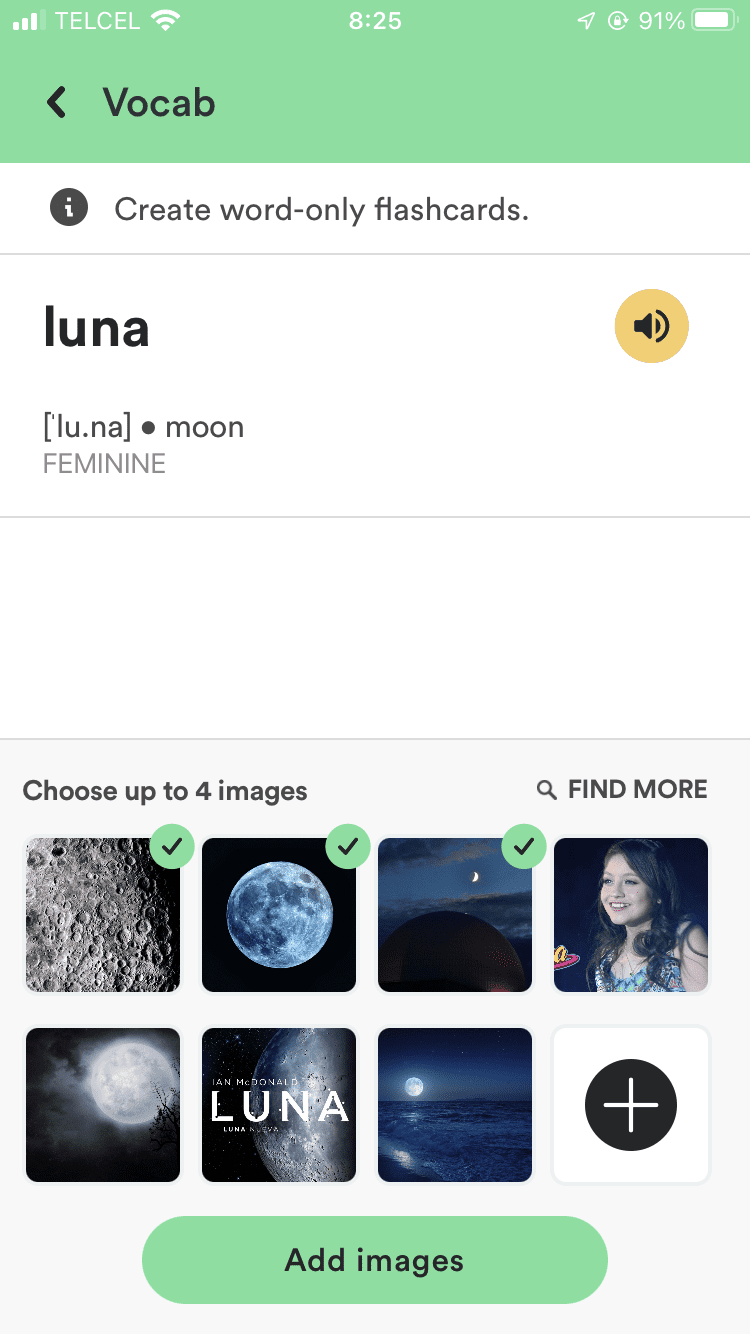
Stage 3: Learn grammar through stories
With some essential vocabulary under your belt, you’ll start learning grammar the right way. In short, you won’t be poring through old books and memorizing conjugation tables. However, what you will be doing is learning through sentences you know, with vocabulary that is valuable to you.
The app gives you access to more than 1,500 grammar sentences per language, and you’ll learn grammar through those sentences that resonate with you or that you might find useful. Additionally, you can even create your own sentences and save them in the app!
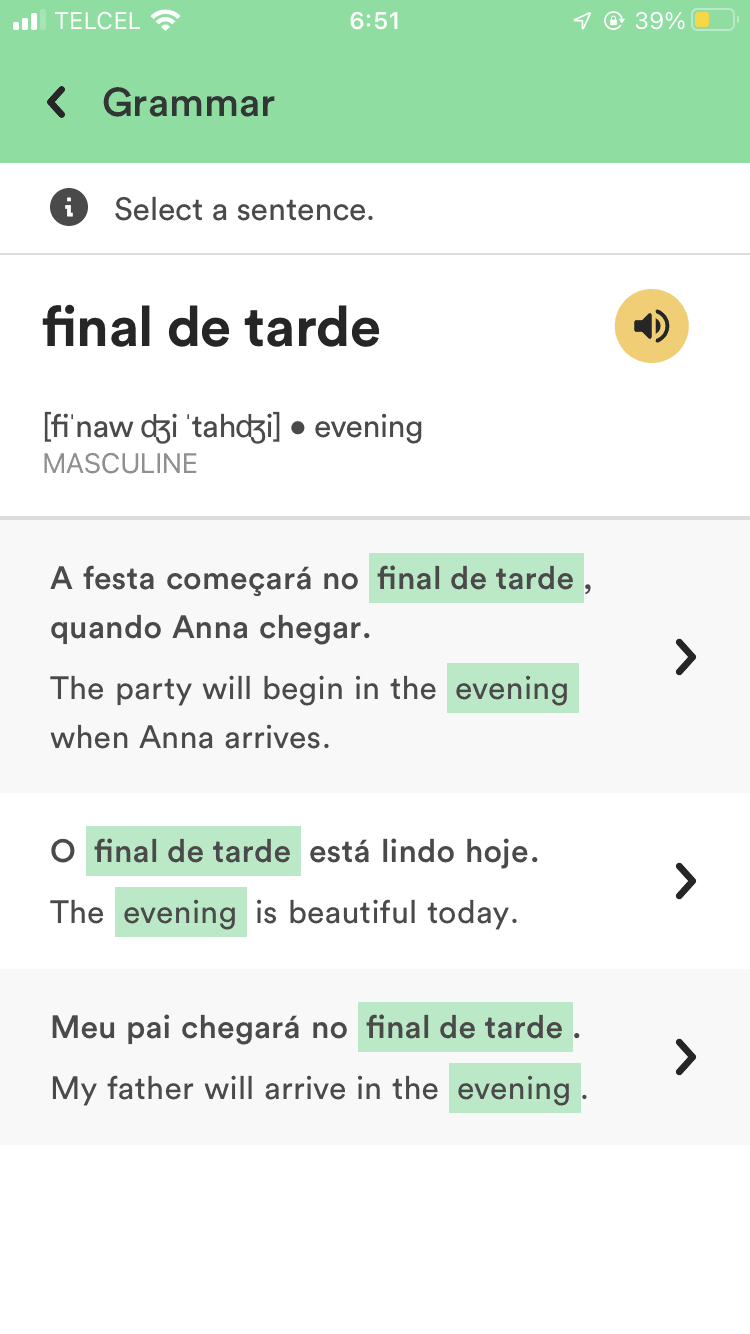
Stage 4: Live Coaching
Finally, alongside the app, Fluent Forever’s Live Coaching will supercharge your language journey in different ways. Firstly, it will let you practice with your very own native speaker coach in 1-on-1 sessions. Secondly, The sessions are completely flexible, and they’re custom-designed to incorporate subjects you care about. This is a highly effective coaching method that encourages you to engage in meaningful conversations you’ll remember long after the session is up. Lastly, Live Coaching gives you automatic access to the Fluent Forever app, where you can upload the sentences and phrases you create with your coach to practice anytime.
And there you have it! In summary, the tips in this article show you, without a doubt, the fastest way to learn a language for good. So, are you ready? The sooner you start, the better!
Disclaimer: as an Amazon Associate, Fluent Forever earns from qualifying purchases.
[shareaholic app="share_buttons" id="28313910"]










